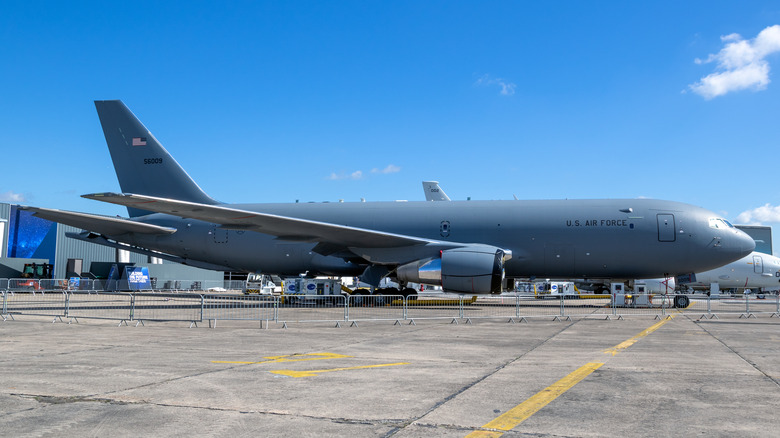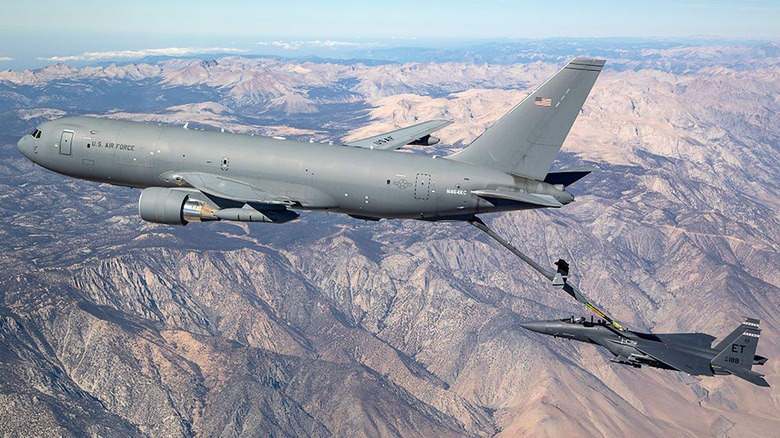Here's Why Boeing's KC-46 Pegasus Tanker Is So Important
Despite the recent and disastrous incidents with its 737 MAX 9 airplanes, Boeing has been a leading civilian and military aircraft manufacturer for more than 100 years. The KC-46A Pegasus is the latest craft to provide air-to-air refueling services to planes from the Air Force, Navy, and Marine Corps, as well as those of partner nations.
The ability to refuel a plane while still in flight might seem like a modern achievement, but it first occurred over a century ago. On June 27, 1923, a pair of Army Air Services De Haviland DH-4B biplanes successfully funneled gasoline down through a hose from one plane to the other. This proved that mid-air refueling could be accomplished, extending the range of an aircraft as long as needed to keep it on mission.
Boeing purposefully built the first production tanker in 1950. Four propeller-driven Pratt & Whitney engines powered the KC-97 Stratofreighter. It was equipped with a "flying boom" refueling system – a stiff, "telescoping tube with a wing-like stabilizer" manually aligned (by a dedicated operator) with the fuel opening (roughly the size of a plastic SOLO cup) in the top of the receiving plane. This method can transfer fuel at approximately 6,000 pounds per minute.
The KC-97 was replaced with the KC-135 series, culminating in the jet-powered KC-135E, KC-135R, and KC-145T Stratotankers which went on to fly for more than 50 years. They're the aircraft the KC-46A is replacing, bringing a much greater ability to refuel, carry cargo, and execute aeromedical evacuations.
Feeding fuel to fighters
Whereas the Stratofreighter used just a "flying boom" refueling system, the Pegasus uses a probe-and-drogue system (aka hose-and-drogue) in addition to a boom. Instead of a rigid tube, a "long, flexible hose with a funnel-shaped drogue on the end" plugs directly into a retractable probe on the plane needing fuel. This computerized fly-by-wire system can be operated independently from the boom system.
Since the primary function of this plane is to provide fuel to state-of-the-art aircraft, the Pegasus must feature upgrades not seen before. The receiver envelope on the KC-46A's boom is three times larger than the one found on the old KC-135. The KC-46A can carry 212,000 pounds of fuel, and since first being delivered to McConnell Air Force Base in Kansas in January 2019, has offloaded more than 100 million pounds of fuel.
The KC-46A isn't just a passive beast that feeds fuel-starved fighter jets. It's equipped with combat-ready real-time countermeasures, all of which combine "to detect, avoid, defeat, and survive threats." Advanced Battle Management System (ABMS) integration can provide the fleet with situational awareness by exchanging data with the planes during refueling. Additionally, it's hardened against nuclear, chemical, and biological attacks, and the flight deck armor adds another layer of protection.
However, the Pegasus is not without its problems. Not only has it cost Boeing over $7 billion in losses, but it's also in the midst of fixing several "Category 1 deficiencies" with the aircraft. An Air Force spokesperson said these deficiencies are so severe they "may cause death, severe injury, or severe occupational illness" if not corrected.

